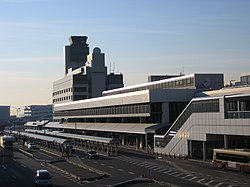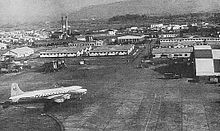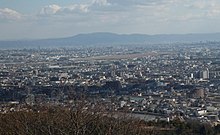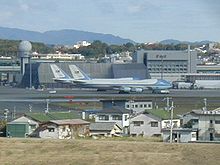Itami Airport
Itami Airport Osaka International Airport 伊丹空港 大阪国際空港 Itami Kūkō Ōsaka Kokusai Kūkō | |||||||||||||||
|---|---|---|---|---|---|---|---|---|---|---|---|---|---|---|---|
 | |||||||||||||||
 | |||||||||||||||
| Summary | |||||||||||||||
| Airport type | Public | ||||||||||||||
| Operator | New Kansai International Airport Co., Ltd. | ||||||||||||||
| Serves | Osaka, Kyoto, and Kobe | ||||||||||||||
| Location | Itami, Hyogo Prefecture Ikeda and Toyonaka, Osaka Prefecture | ||||||||||||||
| Hub for | |||||||||||||||
| Elevation AMSL | 39 ft / 12 m | ||||||||||||||
| Coordinates | 34°47′04″N 135°26′21″E / 34.78444°N 135.43917°E | ||||||||||||||
| Website | osaka-airport | ||||||||||||||
| Map | |||||||||||||||
 | |||||||||||||||
| Runways | |||||||||||||||
| |||||||||||||||
| Statistics (2010) | |||||||||||||||
| |||||||||||||||
Sources: Ministry of Land, Infrastructure, Transport and Tourism (Japan)[1] | |||||||||||||||
Itami Airport (伊丹空港, Itami Kūkō) (IATA: ITM, ICAO: RJOO), officially known as Osaka International Airport (大阪国際空港, Ōsaka Kokusai Kūkō) is the primary domestic airport for the Kansai region of Japan, including the major cities of Osaka, Kyoto and Kobe. It is classified as a first class airport.
Despite its "international" designation, the airport's scheduled passenger air traffic is entirely domestic. Kansai International Airport (27 miles (43 km) away) took over the region's international traffic in 1994 and competes with Itami for domestic traffic. Itami also faces competition from Kobe Airport (16 miles (26 km) away), a smaller domestic airport opened in 2006.
The airport was named after the city of Itami, Hyōgo Prefecture because most of its land is located there. A portion of the airport property is also located in Toyonaka and Ikeda cities of Osaka Prefecture. The terminal complex is located in all three of these cities, and the only access from the Itami side is via a long tunnel that passes below the runway and apron.
In FY2006 Itami was Japan's 3rd busiest airport and the Kansai region's busiest. During 2010, this airport had 62,293 aircraft movements (32 cities). The total number of passengers was 14,193,277. Freight volume was at 125,736 metric tons total.[1][needs update]
History

Itami Airport opened as No. 2 Osaka Airport (第二大阪飛行場, Dai-ni Ōsaka Hikōjō) in 1939. Prior to the opening of Itami, Osaka was served by seaplanes which used an airport at the mouth of the Kizu River. In 1931, the Osaka municipal government drafted plans to construct a new "No. 1 Osaka Airport" near the mouth of the Yamato River, also targeted at seaplanes, but concerns about fog and protests from Kobe-based businesses led the government to build the "No. 2 Airport" for land-based aircraft instead.[2]

Construction began in July 1936 on a 53 ha (131 acre) site. The new airport was primarily used by the Imperial Japanese Army during its early years. U.S. occupation forces took over Osaka Airport after the end of World War II in 1945, expanding it to 221 ha and renaming it Itami Air Base.[3] The airfield was used extensively by US forces during the Korean War.[4] In 1954, Marilyn Monroe and Joe DiMaggio stopped at Itami during their honeymoon and in 1956, the base was used in the filming of the movie Sayonara.
Itami was renamed Osaka Airport (大阪空港, Ōsaka Kūkō) following its return to Japanese control in March 1959. The Japanese government quickly implemented a plan to expand the airport by an additional 82.5 ha so that it could accommodate jet aircraft. Despite some protests from locals, the plan was approved by the neighboring city assemblies between 1960 and 1961 with strong backing from local business groups, and land was purchased between 1962 and 1964, in part out of the aviation industry's interest in keeping pace with the development of the Tokaido Shinkansen high-speed rail link between Tokyo and Osaka. The main runway was completed in 1970.[4]

In its heyday Itami was served by a variety of major international carriers, including Pan Am (Japan routes transferred to United in 1985), British Airways, Air India, Cathay Pacific and Korean Air. Northwest Airlines was a major international operator at Itami, and by 1992 offered nonstop service to New York, Los Angeles, Honolulu and Sydney.[5] The Sydney service raised Japanese regulator concern because less than 30% of passengers on the Australia-Japan segment were originating in the U.S., against its rule to be over 50 percent.[6]
Political friction

While Japan's economy was growing rapidly, the area around Itami Airport became an increasingly dense residential area for commuters to Osaka.
A number of factors made the airport an intensely debated political issue in the 1960s and 1970s, among them:
- The introduction of jet aircraft made noise and air pollution a growing concern among locals.
- The United States Armed Forces had rights to use Itami Airport for refueling and maintenance, and frequently sent military aircraft there for overhauls at the Shin Maywa Industries plant there. This activity caused consternation among locals who were opposed to the Vietnam War.
Jet flights at Itami began on June 1, 1964 and triggered complaints by neighboring residents about noise pollution.[4] In addition, eminent domain procedures were used in 1966 to obtain land for the runway expansion at Itami and led to local protests, as had also been the case in the construction of Narita International Airport near Tokyo.[7]
In May 1968, a group of local citizens decided to sue the government for damages related to noise pollution from Itami Airport. The lawsuit was filed in December 1969. The Japanese government concurrently banned takeoffs and landings at Itami between 10:30 PM and 6:30 AM, effective February 1970.[4]
In February 1974, the Osaka District Court issued a qualified ruling in favor of the plaintiffs which limited the scope of their damages. The plaintiffs appealed to the Osaka High Court, which ruled in November 1975 that the plaintiffs were entitled to both a wider scope of damages and an injunction halting flights at the airport between 9 PM and 7 AM. This was a landmark decision in Japanese environmental law as it set a precedent for polluters to be enjoined and to be required to pay damages to victims. However, the state then appealed to the Supreme Court of Japan, which deliberated for almost six years before ruling in 1981 that the High Court injunction was illegal (though the victims remained entitled to damages).[4]
By the mid-1970s, the airport was subject to extensive slot restrictions, with operations limited to 200 jets and 170 propeller aircraft per day, and no takeoffs or landings allowed after 9 PM. These restrictions led the major domestic airlines to adopt more widebody aircraft in ultra-high-density configurations on Itami routes. The introduction of these widebodies caused additional concern among locals who protested the increased pollution and greater dangers in the event of a crash.
Domestic era

Because of the political friction surrounding Itami, planners began work in the 1970s to relocate many of its flights to an offshore location. This plan led to the opening of Kansai International Airport in 1994 on an artificial island in Osaka Bay.[7]
There were originally plans to close Itami Airport following the opening of Kansai, but nearby communities opposed such a move for economic reasons, so Itami was retained as a domestic-only airport after Kansai opened in 1994. Itami has been used by international charters for state visits -- Air Force One visited Itami in November 2005 and Chinese premier Wen Jiabao landed at Itami in April 2007[8] -- and by Asiana Airlines charter flights to and from South Korea in late 2015.[9] All Nippon Airways retains a large maintenance base at Itami which occasionally services aircraft ferried in from overseas without passengers, and some international cargo flights continue to use the airport as well.
The policy of the Japanese government has been to limit operations at Itami in order to spur development at Kansai and Kobe.[10] Commercial passenger aircraft with more than two engines were banned from Itami effective April 2006, although such aircraft may continue to make ferry flights to and from Itami for maintenance purposes. All Nippon Airways flew a 747 to Itami on January 12, 2014, the first 747 operation at the airport in eight years, for an open house event to commemorate the upcoming retirement of ANA's 747 fleet in March 2014.[11]
The government proposed changing Itami's status from first-class airport to second-class airport, which would saddle local governments with one-third of its operating costs; after protests from the surrounding local authorities, the national government withdrew this proposal. The government also proposed banning widebody aircraft from Itami, although this proposal was criticized as unrealistic given the volume of traffic there.
In May 2011, the Diet of Japan passed legislation to form a new Kansai International Airport Corporation using the state's existing equity stake in Kansai Airport and its property holdings at Itami Airport. The move was aimed at offsetting Kansai Airport's debt burden.[12] NKIAC started free shuttle bus service between Itami and Kansai for transfer passengers in order to further integrate the two as a single hub. Itami has also seen increased domestic passenger traffic in 2013 following the easing of flight restrictions, which was possible due to propeller aircraft being replaced by quieter regional jets; JAL was able to increase the frequency on its Itami-Fukuoka route from two flights to five flights daily, making the route more competitive with the Sanyō Shinkansen rail service.[13]
In September 2013, NKIAC announced that it would acquire Osaka Airport Terminal Co. for 27.8 billion yen, which an NKIAC official called the "last piece" of the integration of both airports' management.[14] NKIAC plans to market Itami Airport to business travelers by touting its convenience for domestic business travel and improving its connectivity to Narita International Airport, while continuing to market Kansai Airport to leisure and international travelers.[15]
Plans
Itami is limited to domestic flights, and can only handle 18 landings per hour and 370 landings per day. As of July 2013[update], NKIAC is considering easing these restrictions through negotiations with local authorities, on the basis that modern aircraft are quieter than those in operation when the restrictions were imposed. NKIAC hopes to coordinate with local governments to increase the number of slots allowed during the day and to open additional slots during nighttime hours.[10]
Both Hyogo Prefecture and Itami City are supporters of expanded service at Itami, and established a formal coordination body in July 2013 to propose further reforms such as allowing international charter flights, and to engage in local efforts such as improving ground transportation and publicizing the airport's convenience. They planned to enlist the support of the other neighboring municipalities of Toyonaka, Takarazuka and Ikeda.[16] On the other hand, the Japanese government has supported Kansai at Itami's expense,[10] and current Osaka City mayor and former Osaka Prefecture governor Toru Hashimoto has been a particularly vocal critic of the airport, arguing that the Chuo Shinkansen maglev line will make much of its domestic role irrelevant, and that its domestic functions should be transferred to Kansai in conjunction with upgraded high-speed access to Kansai from central Osaka. In 2009, Hashimoto proposed closing Itami and converting the site into an "International Campus Freedom City" operating in the English language with 20,000 residents; the governor of Hyogo criticized the idea as "complete nonsense."[17] Hashimoto later expressed support for Transport Minister Seiji Maehara's plan to maintain Itami with further restrictions on the size of aircraft.[18]
Kansai International Airport Corporation conducted a public tender to sell the operating rights for Kansai and Itami Airport in May 2015. Orix and Vinci SA were the sole bidder for the 45-year contract, at a price of around $18 billion.[19] The new operating company will be formed around the end of 2015 and will be 80% owned by Orix and Vinci, with the remaining 20% owned by Kansai-based enterprises such as Hankyu Hanshin Holdings and Panasonic.[20]
Accidents and incidents
- 30 September 1957: Douglas DC-4 JA6011 of Japan Airlines suffered a number one engine failure on takeoff and stalled, crash landing in a rice paddy in Toyonaka. Seven were injured.[21]
- 12 June 1961: Vickers Viscount G-APKJ of All Nippon Airways was damaged beyond economic repair when the starboard undercarriage collapsed following a heavy landing.[22]
- 26 October 1986: Thai Airways Flight 620, from Don Mueang International Airport of Bangkok via Ninoy Aquino International Airport of Manila, this plane incident of suddenly exploded in the fuselage rear, rapid decompression occurs. As a result of this explosion suffered damage such as the loss of two systems of the hydraulic system lines were damaged. This aircraft was a dutch roll state becomes a temporary maneuver impossible, but after 40 minutes, was successful emergency landing at Osaka Airport. According to official confirmed report, 109 persons wonded, as total 233 passenger and 14 crews on this board.[23]
Terminals, airlines and destinations
Itami Airport has a single terminal building with 21 gates, divided into a "North Terminal" for JAL and Amakusa and "South Terminal" for ANA and IBEX. The departure and arrival zones of the two terminals are connected by a "Central Block" containing shops, restaurants and a hotel.[24]
The terminal is planned to be extensively renovated by August 2020 to include a new pier for regional jet aircraft, consolidated departures and arrivals facilities (including a single central security checkpoint with expanded capacity) and a new shopping and dining area. Work began in February 2016, and the renovated central area is scheduled to become operational in 2018.[25]
Passenger
| Airlines | Destinations | Terminal |
|---|---|---|
| Air Do | Sapporo-Chitose | North |
| All Nippon Airways | Aomori, Fukuoka, Hakodate, Hanamaki, Kagoshima, Kumamoto, Miyazaki, Nagasaki, Okinawa, Tokyo-Haneda, Tokyo-Narita, Sapporo-Chitose, Sendai Seasonal: Akita, Kushiro | South |
| All Nippon Airways operated by ANA Wings | Fukuoka, Fukushima, Kōchi, Matsuyama, Niigata, Oki, Ōita, Shizuoka, Tokyo-Narita | South |
| All Nippon Airways operated by Ibex Airlines | Akita, Aomori, Fukuoka, Hiroshima, Oki, Sendai Seasonal: Iwami, Matsumoto | South |
| Amakusa Airlines | Amakusa, Kumamoto | North |
| Japan Airlines | Amami Ōshima, Fukuoka, Kagoshima, Memanbetsu, Okinawa, Sapporo-Chitose, Sendai, Tokyo-Haneda, Tokyo-Narita | North |
| Japan Airlines operated by J-Air | Akita, Aomori, Fukuoka, Fukushima, Hakodate, Hanamaki, Kagoshima, Kumamoto, Misawa, Miyazaki, Nagasaki, Niigata, Ōita, Yamagata | North |
| Japan Airlines operated by Japan Air Commuter | Hiroshima, Izumo, Iki, Oki, Tajima, Tokyo-Narita, Yakushima | North |
Statistics
Top destinations
| Rank | Airport | Passengers | Carriers |
|---|---|---|---|
| 1 | Haneda Airport | 5,274,627 | All Nippon Airways, Japan Airlines |
| 2 | Naha Airport | 923,752 | All Nippon Airways, Japan Airlines |
| 3 | Sendai Airport | 894,926 | All Nippon Airways, Japan Airlines |
| 4 | New Chitose Airport | 817,364 | All Nippon Airways, Japan Airlines |
| 5 | Kagoshima Airport | 701,233 | All Nippon Airways, Japan Airlines |
| 6 | Fukuoka Airport | 670,759 | All Nippon Airways, Japan Airlines |
| 7 | Miyazaki Airport | 538,827 | All Nippon Airways, Japan Airlines |
| 8 | Matsuyama Airport | 518,114 | All Nippon Airways, Japan Airlines |
Source: Ministry of Land, Infrastructure and Transport Civil Aviation Bureau 2014
Ground transportation
This section needs additional citations for verification. (June 2016) |
Rail

The only direct rail connection to the airport is the Osaka Monorail, which stops in the northern suburbs of Osaka, connecting to the Hankyu Takarazuka Line at Hotarugaike and the Kita-Osaka Kyuko Railway (Midosuji Line) at Senri-Chuo.[citation needed]
| « | Service | » | ||
|---|---|---|---|---|
| Osaka Monorail Main Line (11) | ||||
| Terminus | - | Hotarugaike (12) | ||
There have been various plans and studies to improve rail access to the airport, including spurs from the JR Takarazuka Line and Hankyu Takarazuka Line, an extension of the Osaka Monorail to central Itami and a separate light rail connection between the airport and central Itami, but none of these studies have been implemented due to financial considerations as well as limited capacity on the existing rail lines to the area.[citation needed]
Road
Itami Airport is directly connected to the Hanshin Expressway Ikeda Route and is five minutes' drive from the Chugoku Expressway, making it possible to reach central Osaka by car or bus in 25 to 30 minutes, central Kobe in 40 minutes and central Kyoto in 55 minutes.[26]
References
- ^ a b Osaka Airport Briefcase
- ^ 関西の空港史(20060531)
- ^ Itami Air Base
- ^ a b c d e Shigeto Tsuru, The political economy of the environment: the case of Japan.
- ^ "Northwest Airlines timetable, 12/15/1992". Retrieved 29 August 2013.
- ^ "Japan May Move Against Northwest Airlines," The New York Times, March 12, 1993.
- ^ a b Daniel P. Aldrich, Site Fights: Divisive Facilities and Civil Society in Japan and the West
- ^ 京で一服 友好の舞台 温家宝首相 入洛, Kyoto Shimbun, April 13, 2007.
- ^ "ASIANA AIRLINES Files Osaka Itami Charters in late-Sep 2015". Routes Online. Retrieved 2016-09-30.
- ^ a b c "伊丹発着枠を将来拡大も 新関空常務、地元理解を前提に". 日本経済新聞. 16 July 2013. Retrieved 17 July 2013.
- ^ 米田, 堅持 (12 January 2014). "ANA:ジャンボ機が大阪・伊丹に8年ぶり飛来". Mainichi Shimbun. Retrieved 12 January 2014.
- ^ "関空・伊丹統合法が成立 1兆円超す負債解消目指す". Asahi Shimbun.
- ^ "伊丹、規制緩和で活性化 関空と経営統合1年". 日本経済新聞.
- ^ "新関空、運営権売却へ前進 伊丹ビル会社を年内買収へ". 日本経済新聞. 4 September 2013. Retrieved 4 September 2013.
- ^ "関空・伊丹の運営権売却「14年度中に実現」 新関空会社社長". 日本経済新聞. 26 September 2013. Retrieved 26 September 2013.
- ^ "伊丹空港の利用促進へ協議会 兵庫県と市が設立". 日本経済新聞. 13 July 2013. Retrieved 16 July 2013.
- ^ Airport wars roil Kansai region, Japan Times
- ^ Osaka governor supportive of idea to reduce Itami airport's role, Associated Press
- ^ Fujita, Junko (22 May 2015). "Orix only confirmed bidder for Kansai airport rights after more drop out". Reuters. Retrieved 14 September 2015.
- ^ 伊藤, 正泰 (11 September 2015). "新関空会社とオリックス陣営、空港運営権の売却で大筋合意". The Nikkei. Retrieved 14 September 2015.
- ^ Template:Ja icon 日本航空雲仙号不時着事故 - Wikipedia. Ja.wikipedia.org. Retrieved on 2013-08-16.
- ^ "Accident description". Aviation Safety Network. Retrieved 14 September 2009.
- ^ Template:Ja icon タイ航空機爆発事件 - Wikipedia. Ja.wikipedia.org. Retrieved on 2016-09-20.
- ^ "Floor Guide" (PDF). Osaka International Airport. Retrieved 12 December 2013.
- ^ Yoshikawa, Tadayuki (28 February 2016). "伊丹空港、リニューアル開業20年8月に 到着口集約、MRJ桟橋新設". Aviation Wire. Retrieved 1 March 2016.
- ^ 交通アクセス | 大阪国際空港(伊丹空港). Osaka-airport.co.jp. Retrieved on 2014-04-12.

